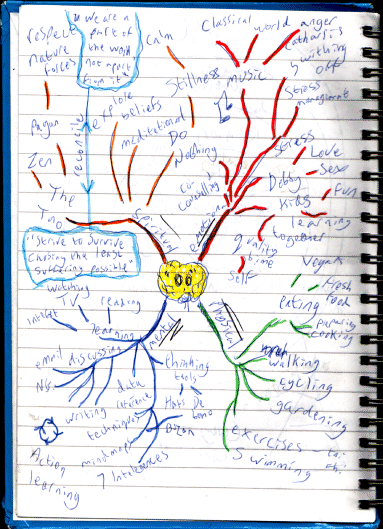Notetaking
From Wikipedia, the free encyclopedia
Notetaking is the practice of writing pieces of information, often in an informal or unstructured manner. One major specific type of notetaking is the practice of writing in shorthand, which can allow large amounts of information to be put on paper very quickly. Notes are frequently written in notebooks, though any available piece of paper can suffice in many circumstances—some people are especially fond of Post-It notes, for instance. Notetaking is an important skill for students, especially at the college level. Many different forms are used to structure information and make it easier to find later. Computers, particularly tablet PCs and personal digital assistants (PDAs) are beginning to see wide use as notetaking devices.
Professional Notetakers provide access to information for people who cannot take their own notes, in particular Deaf and hard of hearing people. Manual notetaking requires pen and paper and Electronic Notetaking (or Computer-Assisted Notetaking) requires laptops with special notetaking software. Professional Notetakers most frequently work in colleges and universities but also in workplace meetings, appointments, conferences, and training sessions. They are usually educated to degree level. In the UK they are increasingly expected to have a professional notetaking qualification, such as that offered by the Council for the Advancement of Communication with Deaf People (CACDP).
Contents |
[edit] Systems
[edit] Cornell Notes
When using the Cornell note-taking system a column of white space is left to the left side of the notes that are written as they come up. Questions or key words based on the notes are written in the white space after the session has ended. The Cornell method requires no rewriting and yet results in systematic notes.
[edit] Charting
Charting is creating a graph with symbols, or table with rows and columns. Graphs and flow-charts are useful for documenting a process or event. Tables are useful for facts and values
[edit] Outlining
While notes can be written freely, many people structure their writing in an outline. A common system consists of headings that use Roman numerals, letters of the alphabet, and the common Arabic numeral system at different levels. A typical structure would be:
- I. First main topic
- A. Subtopic
- 1. Detail
- 2. Detail
- B. Subtopic
- A. Subtopic
- II. Second main topic
- A. Subtopic
However, this sort of structure has limitations in written form since it is difficult to go back and insert more information. Adaptive systems are used for paper-and-pen insertions, such as using the back side of the preceding page in a spiral to note insertions. It is possible to simply leave large spaces in between. (See Category:Outliners for more about application software that supports outlining.)
[edit] Mapping
Here, ideas are written in a tree structure, with lines connecting them together. Mind maps are commonly drawn with a central point, purpose or goal in the center of the page and then branching outward to identify all the ideas connected to that goal. Colors, small graphics and symbols are often used to help to visualize the information more easily. This notetaking method is most common among visual learners and is a core practice of many accelerated learning techniques. It is also used for planning and writing essays.
[edit] Sentence method
Every new thought is written as a new line. Speed is the most desirable attribute of this method because not much thought about formatting is needed to form the layout and create enough space for more notes. Also, you must number each new thought.
[edit] SQ3R
SQ3R is a method for taking notes from written material, though it might be better classed as method of reading and gaining understanding. Material is skimmed to produce a list of headings, that are then converted into questions. These questions are then considered whilst the text is read to provide motivation for what is being covered. Notes are written under sections headed by the questions as each of the material's sections is read. One then makes a summary from memory, and reviews the notes.
[edit] Electronic notetaking methods
The growing ubiquity of laptops in universities and colleges has led to a rise in electronic notetaking. Many students write their notes in word processors. Online word processor applications are receiving growing attention by students who can forward notes using email or otherwise make use of collaborative features in these applications.
Online notetaking has created problems for teachers who must balance educational freedom with copyright and intellectual property concerns regarding course content.[citations needed]
[edit] See also
[edit] External links
- Taking notes on philosophical texts by Peter Suber.


